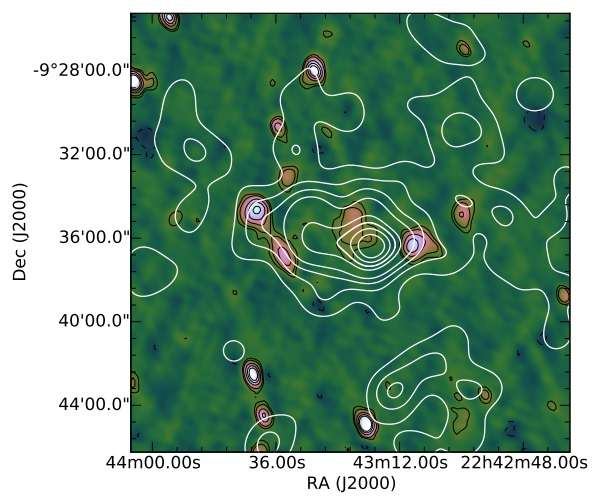Colourscale image of diffuse emission in MACS J2243.3-0935 with black contours overlaid showing the tapered image. Contours are at -3, 3, 5, 10, 15, 20 × σrms where σrms = 200 µJy/beam. Galaxy density contours overlaid in white. These contours are range from 20 to 90 percent of the peak value in steps of 10. Credit: Therese Cantwell et al., 2016.
(Phys.org)—Radio halos are enormous regions of diffuse radio emission, usually found at the centers of galaxy clusters. Recently, an international team of astronomers has discovered such a large area of diffuse emission, estimated to be about three million light years wide. The newly detected halo is located in a distant massive merging galaxy cluster designated MACSJ2243.3-0935. The findings are presented in a research paper published online on Feb. 18 in the arXiv journal.
The researchers, led by Therese Cantwell of the Jodrell Bank Centre for Astrophysics at the University of Manchester, U.K., have used two radio telescopes to make the detection. Located in South Africa, the KAT-7 telescope was employed to observe MACSJ2243.3-0935 on Sept. 7, 2012. Nearly two years later, on June 20, 2014, the team used the Giant Meterwave Radio Telescope (GMRT) in India to conduct follow-up observations of this galaxy cluster. KAT-7 is an array of seven antennas with diameters of 12 meters, while GMRT consists of 30 antennas with diameters of 45 meters.
It was quite challenging to detect the radio halo as these diffuse emissions generally have very low surface brightness, particularly at GHz frequencies, making them hard to detect. Therefore, as the scientists scan lower frequencies, their brightness increases, unveiling the presence of these radio-emitting regions.
"The GMRT is a very useful telescope for detecting radio halos as it is capable of observing at these lower frequencies. The GMRT is also capable of producing images at both high and low resolutions. This is very important, as there can be compact radio emission from other astronomical objects coincident with the radio halo that can make determining the halo properties difficult. Having high resolution images allows us to remove the contributions of the point sources, while the low resolution images are most sensitive to the halo emission," Cantwell told Phys.org.
The astronomers found out that the radio halo in MACSJ2243.3-0935 has flux and dimensions typical of other radio halos. However, they noted that very little is known about these peculiar regions of diffuse emission, including the most important question about their formation.
The formation of radio halos is believed to be linked to the merger of galaxy clusters, which are hugely energetic events—roughly equivalent to a trillion super novae explosions. One formation scenario suggests that turbulence in the gas of the galaxy cluster accelerates particles to radio-emitting energies leading to the production of radio halos. However, not all merging galaxy clusters host radio halos.
"The reason for this is not yet clear, although it is potentially related to how much energy is released in a particular merger event, where a weaker merger does not generate enough turbulence to form a radio halo," Cantwell said.
According to the team, more observations are needed at both lower and higher frequencies in order to investigate different formation scenarios.
In addition to finding the radio cluster, Cantwell and her colleagues also detected a potential radio relic candidate to the west of the cluster. Radio relics, similar to halos, are normally elongated structures found at the periphery of clusters and can be highly polarized. If the existence of this feature is confirmed, it will make MACS J2243.3-0935 one of only a handful of clusters that host both a halo and a relic.
More information: A Newly-Discovered Radio Halo in Merging Cluster MACS J2243.3-0935. arxiv.org/abs/1602.05923
Abstract
We report the discovery of a radio halo in the massive merging cluster MACSJ2243.3-0935, as well as a new radio relic candidate, using the Giant Meterwave Radio Telescope and the KAT-7 telescope. The radio halo is coincident with the cluster X-ray emission and has a largest linear scale of approximately 0.9 Mpc. We measure a flux density of 10.0±2.0 mJy at 610 MHz for the radio halo. We discuss equipartition estimates of the cluster magnetic field and constrain the value to be of the order of 1 μG. The relic candidate is detected at the cluster virial radius where a filament meets the cluster. The relic candidate has a flux density of 5.2±0.8 mJy at 610 MHz. We discuss possible origins of the relic candidate emission and conclude that the candidate is consistent with an infall relic.
© 2016 Phys.org
























